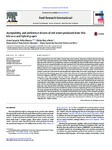Por favor, use este identificador para citar o enlazar este ítem:
http://www.alice.cnptia.embrapa.br/alice/handle/doc/984846| Título: | Acceptability and preference drivers of red wines produced from Vitis labrusca and hybrid grapes. |
| Autor: | BIASOTO, A. C. T.  NETTO, F. M.   MARQUES, E. J. N.   SILVA, M. A. A. P. da   |
| Afiliación: | ALINE TELLES BIASOTO MARQUES, CPATSA; FLÁVIA MARIA NETTO, UNICAMP; EMANUEL JOSÉ NASCIMENTO MARQUES, UNICAMP; MARIA APARECIDA AZEVEDO PEREIRA DA SILVA, UNICAMP. |
| Año: | 2014 |
| Referencia: | Food Research International, v. 62, p. 456-466, 2014. |
| Descripción: | Wines produced from non-Vitis vinifera varieties have great economic importance in Brazil and represent more than 80% of the national production, but scientific information regarding the quality of these wines is rare. The objective of this researchwas to determine consumer acceptability, the sensory profile and the chemical composition of the most consumed Brazilian red wines produced with Vitis labrusca and promising hybrid varieties, identifying the parameters that drive the preference of consumers. Commercial wines collected directly from differentwineries were evaluated regarding their overall acceptance by 120 consumers. Twelve trained panelists developed the sensory profile of the wines using Quantitative Descriptive Analysis (QDA). Physicochemical analyses carried out to determine the pH, titratable and volatile acidity, total solids, alcohol degree, total phenolics, free SO2 and the reducing sugar contents of the wines. The datawas analyzed by ANOVA, Tukey test, Internal Preference Mapping (MDPREF), Cluster analysis, Principal Component Analysis (PCA), Partial Least Square regression (PLS), and Extended Internal Preference Map (EPM). In general wines produced from Ives (V. labrusca) grape showed higher aroma/flavor notes described as sweet, grape, grape juice, blackberry and roses. The wines produced from the hybrid grape Máximo differed from those elaborated with the variety Ives, especially due to their higher intensity of earthy/mushroom, vegetative/green beans, woody and yeast sensory notes. The PLS and EPM analyses indicated that fruity notes associated with the aroma and flavor of grape and grape juice were sensory drivers of Brazilian consumers' preference. On the other hand, the majority of the consumers did not like the sensory notes described as earthy/mushroom, vegetative/green beans and yeast found in the wines produced from Máximo. The wine elaborated exclusively with the hybrid Seibel 2 and the wine containing the V. labrusca grapes Ives and Isabella were preferred by the majority of the consumers and only a minor segment of consumers appreciated the wines elaborated solely with Máximo grape. Thus the hybrid grape Seibel 2 and the recently developed hybrid Máximo were shown to be promising varieties for the winemaking of quality wines in Brazilian regions where the environmental conditions are not good for the cultivation of V. vinifera varieties. |
| Thesagro: | Uva Vitis Vinifera Vitis Labrusca |
| NAL Thesaurus: | Grapes |
| Palabras clave: | Vinho tinto Análises físico-químicas Perfil sensorial Teste de consumidor Híbridos uvas Vitivinicultura |
| Tipo de Material: | Artigo de periódico |
| Acceso: | openAccess |
| Aparece en las colecciones: | Artigo em periódico indexado (CPATSA)  |
Ficheros en este ítem:
| Fichero | Descripción | Tamaño | Formato | |
|---|---|---|---|---|
| Aline2014.pdf | 2.26 MB | Adobe PDF |  Visualizar/Abrir |









